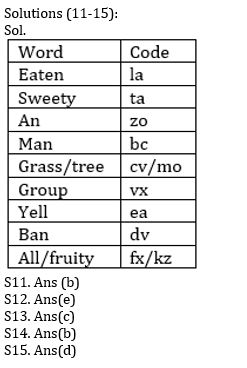Directions (1-5): In this question, relationship between different elements is shown in the statements. The statements are followed by conclusions. Study the conclusions based on the given statement and select the appropriate answer.
Q1. Statements:
L = P ≤ W < V ≤ K ≥ Q; B < L; K = M
Conclusions:
I. B < V
II. M > P
(a) Only conclusion I is true
(b) Only conclusion II is true
(c) Either conclusion I or II is true
(d) Both conclusion I and II are true
(e) Neither conclusion I nor II is true
Q2. Statements:
L = P ≤ W < V ≤ K ≥ Q; B < L; K = M
Conclusions:
I. L ≥ Q
II. W = M
(a) Only conclusion I is true
(b) Only conclusion II is true
(c) Either conclusion I or II is true
(d) Both conclusion I and II are true
(e) Neither conclusion I nor II is true
Q3. Statements:
R ≤ U = B < S; B ≤ X
Conclusions:
I. X > R
II. X = R
(a) Only conclusion I is true
(b) Only conclusion II is true
(c) Either conclusion I or II is true
(d) Both conclusion I and II are true
(e) Neither conclusion I nor II is true
Q4. Statements:
C > U ≤ S < T = O > D ≥ Y; Z = O ≤ P
Conclusions:
I. U > D
II. S < P
(a) Only conclusion I is true
(b) Only conclusion II is true
(c) Either conclusion I or II is true
(d) Both conclusion I and II are true
(e) Neither conclusion I nor II is true
Q5. Statements:
C > U ≤ S < T = O > D ≥ Y; Z = O ≤ P
Conclusions:
I. Z > Y
II. C < O
(a) Only conclusion I is true
(b) Only conclusion II is true
(c) Either conclusion I or II is true
(d) Both conclusion I and II are true
(e) Neither conclusion I nor II is true
Directions (6-10): In these questions, a relationship between different elements is shown in the statements. The statements are followed by two conclusions. Given answer
If A@B means A is not greater than B
A#B means A is not greater than or equal to B
A%B means A is not smaller than B
A$B means A is not smaller than or equal to B
A&B means A is not greater than or smaller than B
Q6. Statement:
C % D $ E & M # J & L
Conclusion:
I. L $ E
II. C % J
(a) if only conclusion I is true.
(b) if only conclusion II is true.
(c) if either conclusion I or II is true.
(d) if neither conclusion I nor II is true.
(e) if both conclusions I and II are true.
Q7. Statement:
P & N @ Q $ R $ T & S
Conclusion:
I. N % S
II. P @ Q
(a) if only conclusion I is true.
(b) if only conclusion II is true.
(c) if either conclusion I or II is true.
(d) if neither conclusion I nor II is true.
(e) if both conclusions I and II are true.
Q8. Statement:
J % P & I % M # T % V
Conclusion:
I. M @ J
II. V $ P
(a) if only conclusion I is true.
(b) if only conclusion II is true.
(c) if either conclusion I or II is true.
(d) if neither conclusion I nor II is true.
(e) if both conclusions I and II are true.
Q9. Statement:
M @ X @ E $ F & D # O
Conclusion:
I. D $ M
II. F @ M
(a) if only conclusion I is true.
(b) if only conclusion II is true.
(c) if either conclusion I or II is true.
(d) if neither conclusion I nor II is true.
(e) if both conclusions I and II are true.
Q10. Statement:
E @ F & D # O % K $ G
Conclusion:
I. O # E
II. G % F
(a) if only conclusion I is true.
(b) if only conclusion II is true.
(c) if either conclusion I or II is true.
(d) if neither conclusion I nor II is true.
(e) if both conclusions I and II are true.
Directions (11-15): Study the information and answer the following questions:
In a certain code language
‘Eaten sweety an man’ is written as ‘la bc ta zo’,
‘Grass tree eaten group’ is written as ‘cv vx la mo’,
‘Group an yell ban’ is written as ‘zo dv ea vx’,
‘Ban all sweety fruity’ is written as ‘fx ta kz dv’,
Q11. What is the code for ‘man’ in the given code language?
(a) la
(b) bc
(c) ta
(d) zo
(e) None of these
Q12. What is the code for ‘tree’ in the given code language?
(a) cv
(b) vx
(c) la
(d) mo
(e) Cannot be determined
Q13. What is the code for ‘yell’ in the given code language?
(a) zo
(b) dv
(c) ea
(d) vx
(e) None of these
Q14. What is the code for ‘ban’ in the given code language?
(a) zo
(b) dv
(c) ea
(d) vx
(e) None of these
Q15. What would be the possible code for ‘grass fruity taste’ in the given code language?
(a) cv mo yu
(b) fx kz ua
(c) ua cv zo
(d) sn cv fx
(e) kz fx mo
Solutions
S1. Ans. (d)
S2. Ans. (e)
S3. Ans. (c)
S4. Ans. (b)
S5. Ans. (a)
Solutions (6-10):
S6. Ans. (a)
Sol. I. L $ E (true) II. C % J (false)
S7. Ans. (b)
Sol. I. N % S (false) II. P @ Q (true)
S8. Ans. (a)
Sol. I. M @ J(true) II. V $ P(false)
S9. Ans. (c)
Sol. I. D $ M (false) II. F @ M(false)
As D=F
S10. Ans. (d)
Sol. I. O # E(false) II. G % F(false)






 GA Capsule for SBI Clerk Mains 2025, Dow...
GA Capsule for SBI Clerk Mains 2025, Dow...
 The Hindu Review October 2022: Download ...
The Hindu Review October 2022: Download ...
 World Malaria Day 2025
World Malaria Day 2025




